“To stay competitive, we need to change the way we manage our projects. This requires change in our culture. This is the change that I boost from my position. Therefore, we want to start with Kanban”.
Executive management decisions and leadership determine a company’s purpose, behaviors, relationships, work practices and ability to adapt to changes in their business environment quickly with endurable economic impact. Developing a resilient and robust business with fast changes always happening in the market, technological, and social environment is a challenging goal. Therefore, the usual questions C-level Managers ask are related to what developing business agility implies for senior-level managers and how to define the right approach to it.
Three years ago, David Anderson and I launched the Kanban Maturity Model. Since then we have been teaching and helping a number of Kanban coaches to understand it and to apply it in real business situations. The first case studies are already published on our website. I myself have been using it actively in different business sectors such as finance, insurance and the engineering industry.
The observations and experience that we collected this whole time help us to give pragmatic, actionable guidance to executive managers who want to develop their business agility and are committed to lead these journeys.
What is business agility and what does it imply?
Business agility is a hot topic, and I have talked about it with quite a few senior-level managers and business owners. They all share the need to shorten the time to market, the ability to adapt faster to changes in customer expectations or market context, to increase efficiency, and to reduce costs. However, they have a different understanding of what it implies to develop these abilities.
I would categorize their viewpoints in the following manner:
- Not for us. Managers are agile. Teams have to become Agile too. – These are the managers who believe that all they need is Agile teams and little or no change in middle or senior level management. They think that Agile teams are constructed precisely to cope with changing priorities. Transparent and collaborative forms of work are difficult to accept for this group of bosses. Trey find restrictions and control more powerful than building trust and empowerment.
- We did it without effect. Agile implementation does not bring benefits to the business. – These are managers of companies that have implemented Agile practices at team level and conduct all ceremonies regularly. However, management culture stays the same. No social change has occurred in the organization. Therefore, these organizations see little or no improvement at business level. They feel stuck, unhappy with the situation but not doing anything about it either.
The subtle difference from the first and second group is that those who say “this is not for us” do not even think that change at management level might be necessary, while those who think “we did it without effect” consider that they took actions to improve business agility but the Agile methods were not effective. - We all have to change. Appropriate change of culture and management practices are needed for business agility. – This is the group of business owners and executive managers who understand that growing business agility requires an integral change of culture and management practices at all organizational levels. This change is part of their business strategy.
The CEO of one company told me the following in my first meeting with them:
“To stay competitive, we need to change the way we manage our projects. This requires change in our culture.
This is the change that I boost from my position. Therefore, we want to start with Kanban”.
Until recently, following the inertia might have been possible in relatively stable businesses. However, for the last couple of months the coronavirus crisis changed the business context significantly. Continuing the old way of thinking and behaving is not an option anymore if the business is to survive and thrive in the new situation.
KMM and Business Agility
Business agility requires developing the capabilities that allow the organization to obtain rapid feedback (from customers, the market, technology state of the art, business and sociological context), define goals and move quickly towards them. This implies strong executive management commitment and appropriate actions that unite, align and focus development activities on the new customer expectations and business purpose.
“The Kanban Maturity Model describes practices which develop culture for business agility.
Senior-level leadership is essential to spark the evolution and achieve success.”
The Kanban Maturity Model is based on four pillars which interact strongly:
- Cultural values – Establish the basis for introducing practices.
- Kanban practices – Strengthen values and ensure business outcomes
- Business outcomes – Demonstrate the outcome of practices and culture.
- Managed evolution – Guidelines on how to stress an organization just enough to make it reflect, evolve and become fitter in their business context.
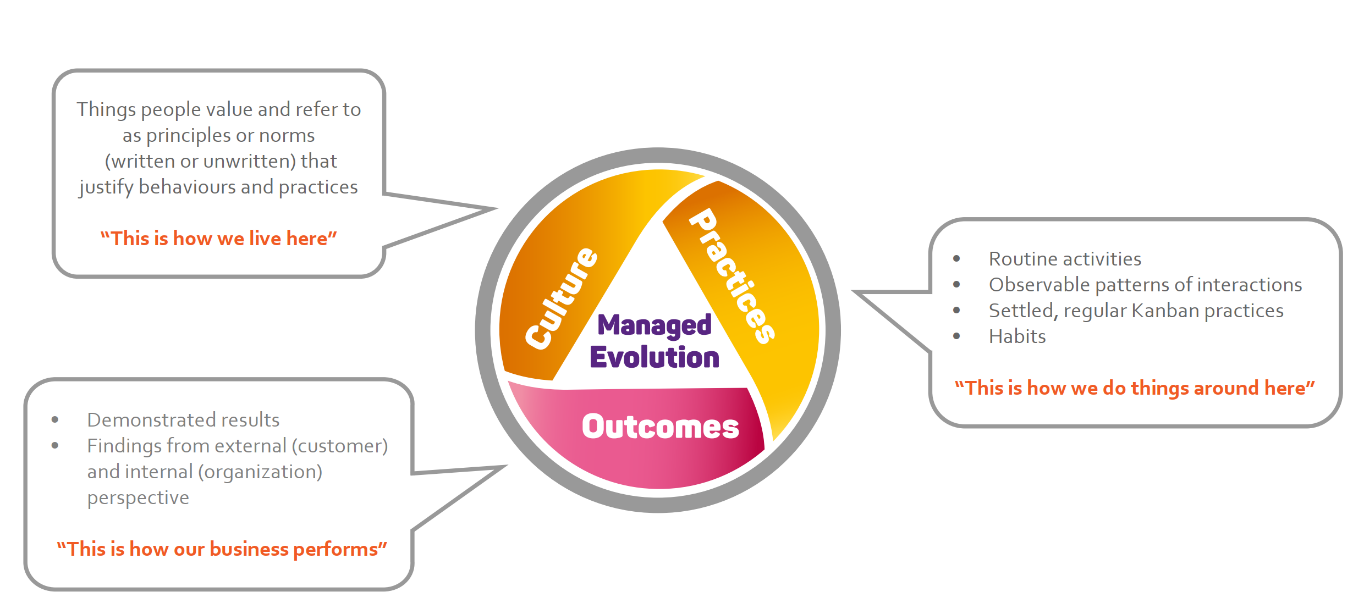
Evolving Through the Organizational Maturity Levels and Executive Management’s Role in It
Our experience with the KMM and with guiding successful evolutionary organizational change shows a pattern of actions and effects. Namely, the following one:
- Start with cultural values – Trigger conversations about new values and desired behaviours that would bring desired benefits to the organization and its people. Make other managers and staff reflect on what practices are necessary to achieve the benefits.
- Introduce appropriate Kanban practices – Select appropriate practices from the maturity level to which the values belong; these practices are proven to prevent resistance, strengthen the values and develop the organizational capabilities for business agility.
Introduce the selected practices by means of scientific experiments. - Turn practices into habits and continue to step 1.
So, how does one start and what should they focus their actions on?
Every organizational context is different. At the same time, when talking about evolving organizational culture and work practices, challenges are quite similar.
Three years of active validation and further development of the KMM have shown us what cultural values and key Kanban practices develop the organizational skills we observe at each organizational maturity level. You can find the descriptions of the full list of Kanban practices in the upcoming book.

If you have employees specialized in particular tasks and working alone on them, make them focus on the assignments. Help them organize their work as to feel proud of their achievement. Let them see themselves as service providers and take accountability for it.
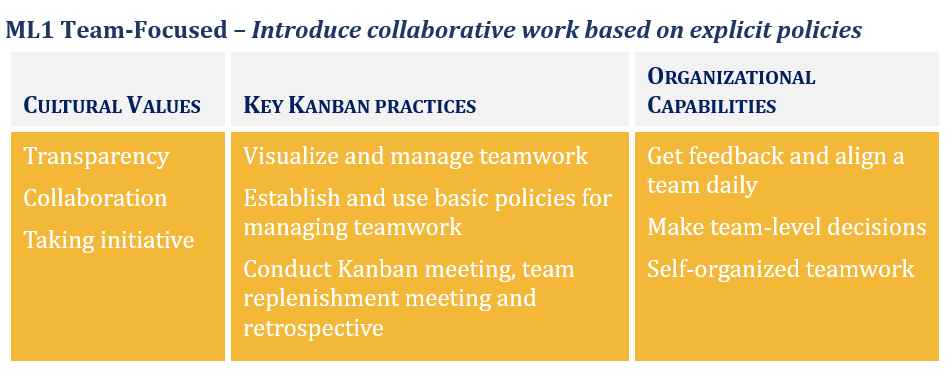
- Focus on making individuals start working collaboratively. Help them see that a team achieves better results than a group of individuals.
- Build their confidence in organizing their work using explicit policies. Everyone has to respect the established policies, including the managers. Substitute the policy “Boss’ requests first” by objective work-related criteria.
- Make them feel proud of what they achieve as a team. Let them take initiative to improve what they see appropriate in order to improve internal organization and delivered results.
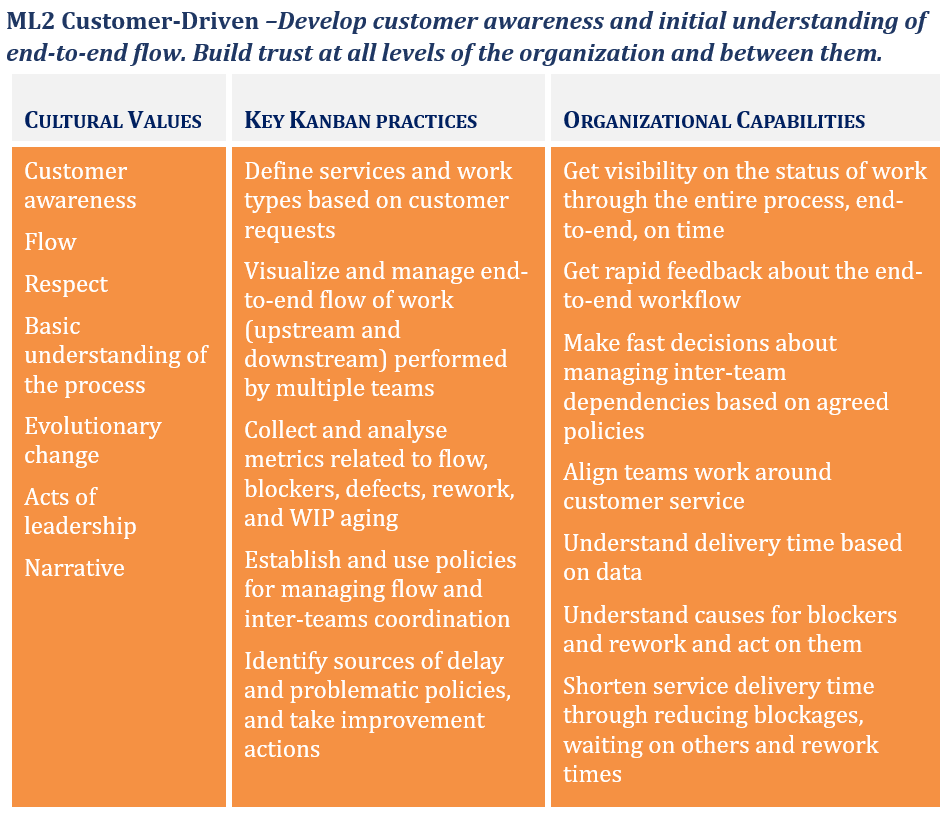
This is the point at which middle and senior-level leadership becomes essential.
- Connect teams and enable their cooperation in an end-to-end workflow which develops and delivers a service to a customer.
- Build the understanding that the team’s job is to deliver a service to a customer or to the wider workflow through which customer value is created.
- Facilitate the definition of explicit policies which manage dependencies between teams and facilitate decision making for a faster flow of results.
- Shift the management focus from ensuring that people are busy to assuring flow, i.e. progression of work towards delivery to the customer.
- Involve the teams in developing the shared understanding of the end-to-end process and what impedes flow. Work with them on identifying, experimenting, and implementing appropriate ideas that improve service/product delivery time and quality as well as issue resolution time and effort.
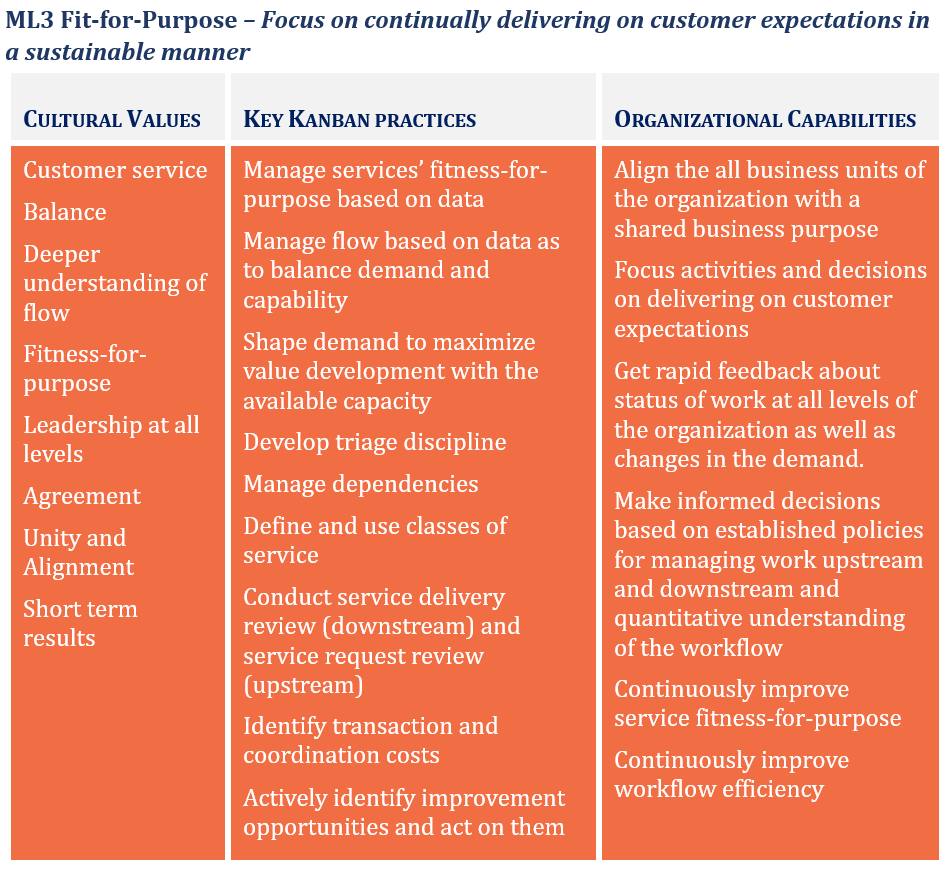
Creating a fit-for-purpose organization goes beyond creating a team or a group of teams delivering a service or product. It is about the entire organization.
At this level executive management role and leadership starts with defining a purpose and working on uniting and aligning the entire organization around this shared purpose. Effectively, this means the following:
- Complement the focus on the customer with the understanding of customer needs and manage services as to ensure that they meet their customers’ expectations
- Encourage and enable that services are managed based on deeper quantitative understanding of flow, demand, and capability, and that decisions for selecting and starting a work item take into consideration available capacity.
- Develop leadership at all organizational levels so that all business units cooperate effectively. Moreover, in critical situations, the managers are able to agree and execute decisions which allow the business to recover rapidly, adapt quickly and thrive.
- Build up the culture of continuous improvement which includes improving sustainability, processes, professional development of individuals, relationships within the organization and with customers.
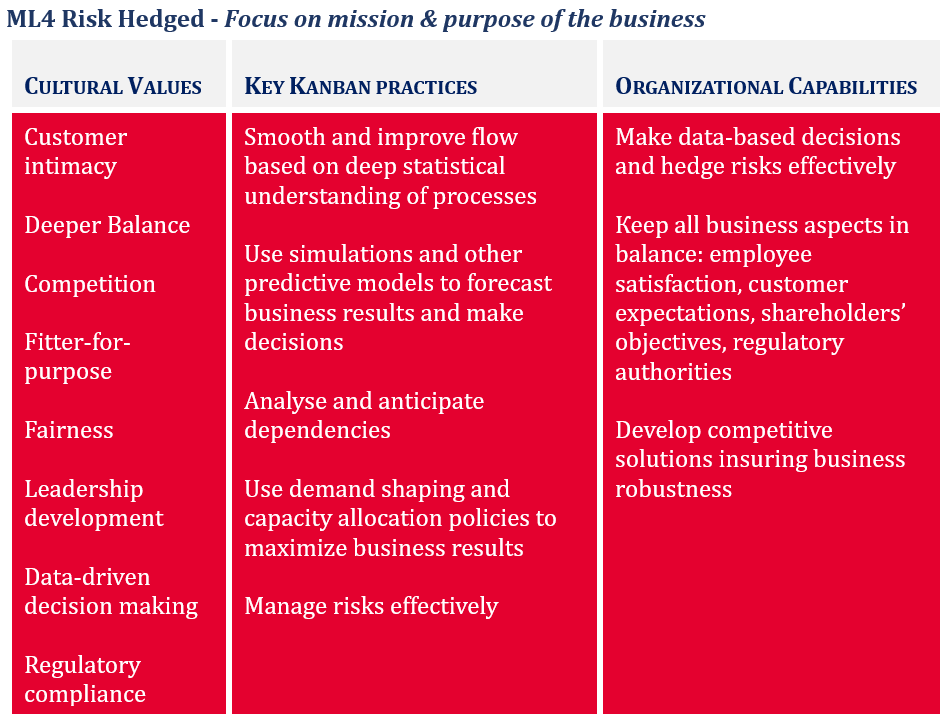
- Educate decision making based on data and statistics, experiment evidences and causal analysis
- Focus actions on maintaining all business aspects in balance: employee satisfaction, fulfilling customer expectations, shareholders’ objectives and regulatory authorities
- Strengthen joint work of employees at different organizational levels to increase trust
- Develop leadership skills to increase unity and alignment while building a culture of competitiveness and fairness.
At maturity level 5 and 6 organizations are focused on optimizing for market leadership, anticipating the future, reinventing the business and ensuring long-term survival.
The majority of the organizations are still at maturity level 1 and 2. Therefore, our principal goal is to help them evolve and build the culture that helps them achieve better business outcomes. Thus, in this article I will not go deeper in the description for ML5&6.


